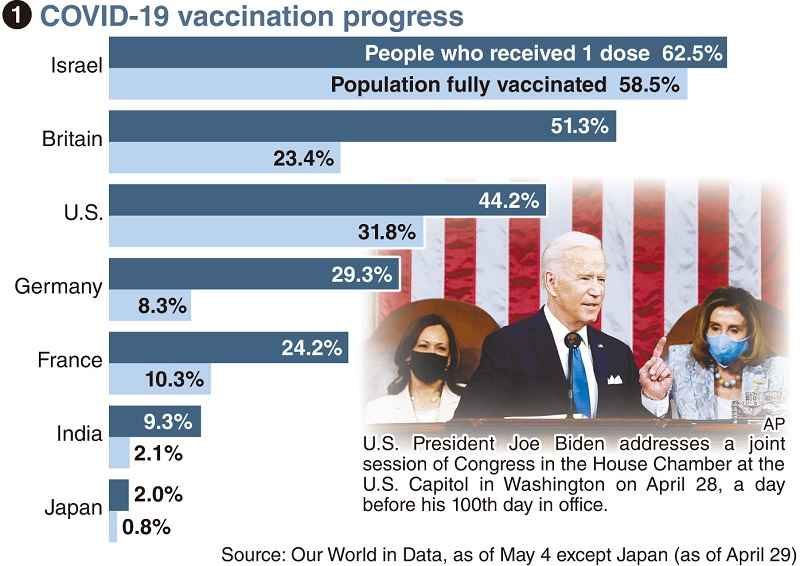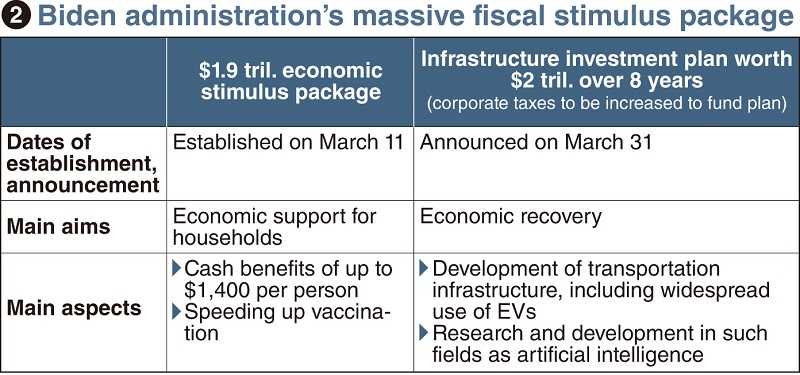
12:35 JST, May 21, 2021
Since U.S. President Joe Biden’s inauguration in January, the U.S. government has made an impressive turnaround from the previous administration of President Donald Trump, with a swift response to the novel coronavirus crisis and the implementation of economic measures in quick succession. On the other hand, some challenges have emerged for the Biden administration. International economics expert Shumpei Takemori shares his views.
50-50
The first 100 days after the inauguration of a new U.S. president are said to be a “touchstone.” The Biden administration is regarded as having succeeded in implementing large-scale economic measures and a vaccination program that is rapidly progressing in its first 100 days. The actions of the new administration also show that politics rules everything in the United States today.
The $1.9 trillion (about ¥210 trillion) economic stimulus package, which focuses on benefits for households, has even been criticized by Democratic economists.
Lawrence Summers, who served as U.S. Treasury Secretary in the administration of U.S. President Bill Clinton, warned that measures to stimulate demand would lead to high inflation. The U.S. government’s economic stimulus package is nearly three times the estimated $700 billion gross domestic product gap (see below).
With the COVID-19 crisis curbing consumption, it is uncertain whether the benefits will cause inflation. Perhaps the new administration has a simpler number in mind: 50.
The Democrats currently have 50 members in the 100-seat U.S. Senate. In case of a tie in votes on Democrat proposals, the vice president votes separately to break the tie, giving them a slim majority.
With Republicans showing no signs of compromise, the Biden administration would lose its executive power if the Democrats lose even one Senate seat in the 2022 midterm elections.
In the past, the Democrats lost their majority and executive power in the midterm elections in 2010 during the Barack Obama administration, and in 1994 during the Clinton administration.
Having experienced such defeats up close, Biden is determined to enact policies that can attract votes, regardless of whether they are pork-barrel policies or risk causing inflation.
Competing for fame
This benefit package is an extension of the $2.2 trillion package that the Trump administration realized in March last year when virus infections were spreading in the United States. The former president, who did not care about balancing the budget, was willing to re-implement the package ahead of the presidential election, but Republican lawmakers were against the policy.
Trump’s influence can also be seen in the success of the vaccine program: 40% of the U.S. population has already received at least one dose.
It was the former president who forced pharmaceutical companies to rush the development of the vaccine with the aim of starting vaccinations in early 2021 in a campaign called Operation Warp Speed.
The Trump administration’s measures against the spread of the virus, which has killed more than half a million people in the United States, were lackluster. Amid mounting criticism, the operation was supposed to be a game changer that would bring about recovery as his administration teetered on the brink of failure.
In short, the prototype for the two policies that are considered to be Biden’s successes came during the Trump administration. Biden has devised a strategy to convert the policies of the previous administration to give the impression that they are “successes” of his administration.
First of all, Biden emphasized the significance of the benefit package as a “distributional policy” to improve the lives of low-income people and made the budget very large.
Secondly, concerning the vaccination program, the Biden administration demonstrated its superior management over the previous administration, which was unfamiliar with the practical duties involved, by promoting orderly vaccinations.
The U.S. vaccination program, which was realized in record time, was the result of the Trump and Biden administrations’ competition for glory. Trump considered the rapid vaccination program to be his game changer. For the Biden administration to achieve results, it needed vaccinations to be administered faster than that of its predecessor’s planned timetable.

Confronting China
Of course, it is not enough for Biden to implement policies with the same objectives as those of Trump: the new president also needs to implement policies that clearly differentiate him from his predecessor.
Unlike Trump, who pursued an “America First” policy, Biden stresses the need to strengthen ties with allies, especially Europe, and to bring the liberal camps together to confront China. Biden has also reiterated the need for active government involvement in the economy — which is a different position from the Republican Party, whose ideal is “small government.”
Public investment to renew aging infrastructures in the United States is also a move to counter the Chinese government’s strong support for its industries. With China in its sights, the U.S. government also is promoting a decarbonization strategy in cooperation with European countries.
Should the United States and Europe jointly take measures against China, which emits a quarter of the world’s carbon dioxide, such as by imposing tariffs on imports from China based on its carbon dioxide emissions, they could use the measures as a weapon to win various concessions from Beijing.
In late March, the Biden administration announced the “American Jobs Plan,” a second package of measures worth about $2 trillion, which includes investments in infrastructure and decarbonization. Unlike his first $1.9 trillion benefit package, this $2 trillion for the plan will be spent over eight years, resulting in a much smaller budget per year. Also, unlike the benefit package that allowed the budget deficit to grow, the plan’s spending is expected to be financed by raising taxes on corporations and high-income earners.
As people’s resistance to this plan is strong in the United States, the U.S. government is expected to have a difficult time getting this plan established.
First of all, centrist Democrats, as well as U.S. industries, have criticized corporate tax hikes.
Secondly, some in the U.S. gas and oil industries strongly oppose the decarbonization program as they believe it will make their world-class status — which was built through shale oil (see below) development — worthless.
It is questionable whether the United States can counter China with this level of budget. The American Jobs Plan aims to update the U.S. rail network, especially to expand the high-speed rail network. At present, however, China’s high-speed rail network covers 24,000 miles (about 38,000 kilometers), while the U.S. network is only 500 miles long.
Difficult decision
Until the Democrats succeed in gaining more Senate seats in the midterm elections, it may be difficult for the Biden administration to take on policies that are fundamentally different from the Trump administration, such as decarbonization.
Under the current circumstances, the administration will need to place its priority on vote-drawing power. However, there are two problems.
First, if all Biden is promoting is the benefit package at this point, the measures will make China’s economy even stronger as the demand stimulated by the benefit package is likely to be directed toward increased imports from China, not toward U.S. industries that lack supply capacity.
Will the United States still be able to confront China under such a situation?
Secondly, if we cannot foresee whether the U.S. government is serious about decarbonization by the midterm elections, it will also be difficult for the Japanese government to determine how much Tokyo should cooperate with Washington regarding decarbonization.
■ GDP gap: The difference between demand such as consumer spending and supply such as the production capacity of factories and stores. The GDP gap is negative when supply is greater than demand.
■ Shale oil : Crude oil extracted from shale deep underground. Technological development began in the 1990s, and drilling activities spread from the mid-2000s. Shale oil, which has dramatically reduced the U.S. dependence on crude oil imports, brought about major changes in the global energy situation.
#Left as original translation, but Oxford dictionary defines shale as “Soft finely stratified sedimentary rock that formed from consolidated mud or clay and can be split easily into fragile plates.”

Shumpei Takemori
Takemori, 65 is chairman of Mitsubishi UFJ Research and Consulting Co. and a senior fellow at the Research Institute of Economy, Trade and Industry. Specializing in international economics, he was a professor at Keio University until March 2021. He also serves as a private sector member of the government’s Council on Economic and Fiscal Policy.
"World" POPULAR ARTICLE
-

8 Japanese Nationals Stranded on Indonesia’s Sumatra Island
-

U.S. Senate Resolution Backs Japan, Condemns China’s Pressure
-

China to Impose Sanctions on Shigeru Iwasaki, Former Head of Japan’s Self-Defense Forces, Who Serves as Adviser to Taiwan’s Executive Branch
-

South Korea’s Top Court Dismisses Nippon Steel Appeal in Lawsuit over Requisitioned Worker
-

75% of Myanmar People Reject Army’s Political Involvement, According to Survey Conducted by Aid Organization
JN ACCESS RANKING
-

Tokyo Economic Security Forum to Hold Inaugural Meeting Amid Tense Global Environment
-

Keidanren Chairman Yoshinobu Tsutsui Visits Kashiwazaki-Kariwa Nuclear Power Plant; Inspects New Emergency Safety System
-

Imports of Rare Earths from China Facing Delays, May Be Caused by Deterioration of Japan-China Relations
-

University of Tokyo Professor Discusses Japanese Economic Security in Interview Ahead of Forum
-

Japan Pulls out of Vietnam Nuclear Project, Complicating Hanoi’s Power Plans

























